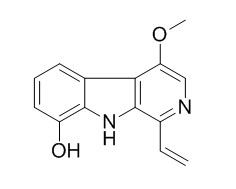Picrasidine I
Picrasidine I has antiosteoclastogenic effect by inhibiting inflammation induced activation of MAPKs, NF-κB and ROS generation followed by suppressing the gene expression of c-Fos and NFATc1 in osteoclast precursors.
Inquire / Order:
manager@chemfaces.com
Technical Inquiries:
service@chemfaces.com
Tel:
+86-27-84237783
Fax:
+86-27-84254680
Address:
1 Building, No. 83, CheCheng Rd., Wuhan Economic and Technological Development Zone, Wuhan, Hubei 430056, PRC
Providing storage is as stated on the product vial and the vial is kept tightly sealed, the product can be stored for up to
24 months(2-8C).
Wherever possible, you should prepare and use solutions on the same day. However, if you need to make up stock solutions in advance, we recommend that you store the solution as aliquots in tightly sealed vials at -20C. Generally, these will be useable for up to two weeks. Before use, and prior to opening the vial we recommend that you allow your product to equilibrate to room temperature for at least 1 hour.
Need more advice on solubility, usage and handling? Please email to: service@chemfaces.com
The packaging of the product may have turned upside down during transportation, resulting in the natural compounds adhering to the neck or cap of the vial. take the vial out of its packaging and gently shake to let the compounds fall to the bottom of the vial. for liquid products, centrifuge at 200-500 RPM to gather the liquid at the bottom of the vial. try to avoid loss or contamination during handling.
J Food Biochem.2020, 44(6):e13198.
Korean Journal of Medicinal Crop Science2018, 26(5):382-390
Heliyon.2023, 9:e21652.
Rec. Nat. Prod.2024, 18:4,405-418.
Herbal Formula Science2024, 32(3):203-221
J Agric Food Chem.2024, 72(40):22237-22249.
Nat Plants.2016, 3:16205
Biochem Pharmacol. 2020, 177:114014.
Oxid Med Cell Longev.2020, 2020:8887251.
Fitoterapia.2018, 124:92-102
Related and Featured Products
Cellular Physiology & Biochemistry, 2017:1425-1435.
Picrasidine I from Picrasma Quassioides Suppresses Osteoclastogenesis via Inhibition of RANKL Induced Signaling Pathways and Attenuation of ROS Production.[Reference:
WebLink]
Osteoporosis is a metabolic bone disorder that tortures about millions of people worldwide. Recent study demonstrated agents derived from picrasma quassioides is a promising drug for targets multiple signaling pathways. However its potential in treatment of bone loss has not been fully understood.
METHODS AND RESULTS:
The bone marrow macrophages (BMMs) were cultured and induced with M-CSF and RANKL followed by Picrasidine I (PI) treatment. Then the effects of PI on osteoclast formation were evaluated by counting tartrate-resistant acid phosphatase (TRAP)-positive multinucleated cells. Moreover, effects of PI on bone resorption activity of mature osteoclast were studied through bone resorption pit counting and actin ring structure analysis. Further, the involved potential signaling pathways cross-talking were investigated by performed Western blotting and quantitative real-time PCR examination. Results demonstrated PI strongly inhibited RANKL induced osteoclast formation from its precursors. Mechanistically, the inhibitory effect of PI on osteoclast differentiation was due to the suppression of osteoclastogenic transcription factors, c-Fos and NFATc1. Moreover, PI markedly blocked the RANKL-induced osteoclastogenesis by attenuating MAPKs and NF-κB signaling pathways. In addition, PI decreased the ROS generation in osteoclast and osteoblast.
CONCLUSIONS:
Taken together our data demonstrate that PI has antiosteoclastogenic effect by inhibiting inflammation induced activation of MAPKs, NF-κB and ROS generation followed by suppressing the gene expression of c-Fos and NFATc1 in osteoclast precursors.



